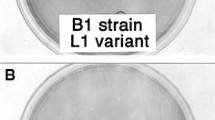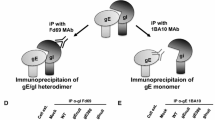Summary.
Glycoproteins gE and gI of bovine herpesvirus 1 (BHV-1) are type I transmembrane proteins that can form a complex that is involved in cell-to-cell spread mechanisms. The extracellular domains of both proteins have cysteine-rich regions that are also found in the homologous proteins of other alphaherpesviruses. The extracellular domain of gE has two conserved cysteine-rich regions: C1 and C2. The other conserved regions in gE are located between C2 and transmembrane region and in the cytoplasmic domain of gE. We studied the complex formation between gE and gI using a series of truncated gE proteins and a full length form and a secreted form of gI. All proteins were expressed in recombinant baculoviruses. To analyse the complex formation between these polypeptides we used monoclonal antibodies (MAbs 67 and 75) that specifically react with the gE/gI complex and not with separately expressed glycoproteins gE and gI alone. This analysis showed that the BHV-1 gE/gI complex can be formed in insect cells after a co-infection with baculoviruses expressing gE and gI in their full length form. When secreted forms of gE and gI were expressed after co-infection, the gE/gI complex was still formed and could also be detected in the tissue culture medium. This gE/gI complex was also formed after mixing the tissue culture media of insect cells expressing the secreted form or gE or gI separately. The smallest part of gE that still formed a complex is encoded by the first 246 residues of gE. This extracellular domain contains only the C1 region, showing that the C2 region is not essential for gE/gI complex formation. Shorter forms of gE encoding the C1 region did not form a detectable complex. We also found that the formation of gE/gI complex is not sufficient for normal cell-to-cell spread of BHV-1. A recombinant BHV-1 gE TM-virus, expressing a truncated glycoprotein E from which the transmembrane and cytoplasmic domain were removed, forms plaques as small as a gE null mutant.
Similar content being viewed by others
Author information
Authors and Affiliations
Additional information
Accepted July 26, 1999/Received March 5, 1999
Rights and permissions
About this article
Cite this article
Tyborowska, J., Bieńkowska-Szewczyk, K., Rychłowski, M. et al. The extracellular part of glycoprotein E of bovine herpesvirus 1 is sufficient for complex formation with glycoprotein I but not for cell-to-cell spread. Arch. Virol. 145, 333–351 (2000). https://doi.org/10.1007/s007050050026
Issue Date:
DOI: https://doi.org/10.1007/s007050050026




